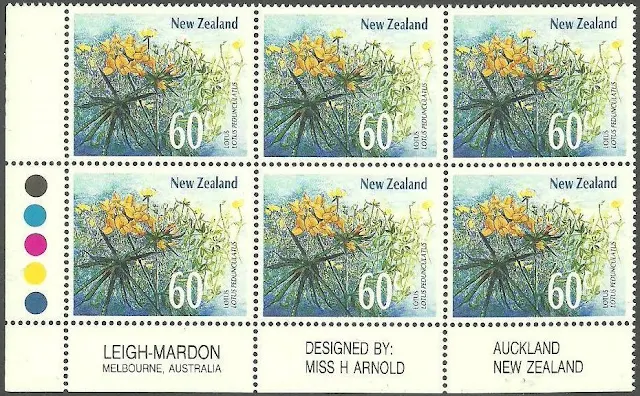From the garden to the countryside you will find wildflowers growing in profusion and somehow this colourful scene brightens the day.
This set contains four introduced pasture or garden flowers which were probably planted by early settlers to remind them of 'home'. The seeds were carried by wind, water and animals to places far beyond the original gardens and now provide colour along our roadsides and over the countryside. In some cases, plants such as the Clover have become assets to New Zealand while others, such as the Wild Ginger they have become problem weeds that people are now encouraged to remove.
The Stamps.
I have included both mint and used examples of each of the four stamps.
(Colour variations are more likely image problems than the stamps themselves.)
40c - Clover (Mint). 40c - Clover (Used).
Clover (Trifolium repens and Trifolium pratense)
The delicacy of its bloom belies the fact that the clover is an extremely hardy and virile plant. Introduced originally from Europe to improve nitrogen levels in pasture, various strains of clover have since been bred but the two pictured here are probably the most familiar. The fragile flowers of the hard working White Clover (repens) and the Red Clover (pratense) can be seen and enjoyed in pastureland throughout New Zealand.
60c - Lotus (Mint). 60c - Lotus (Used).
Lotus (Lotus pedunculatus).
The exotic name given to this European birdsfoot trefoil becomes remarkably apt when the golden bloom is studied closely. The intensity of the colour is almost too rich, too out of place, for a simple wildflower. From its European ancestry, the lotus has inherited a distinct preference for the more moist climate often found in the high country. Why the lotus has been blessed with such beauty no one knows, but those who find it, mingling so well in the New Zealand landscape, can create their own reasons for its attractiveness. The lotus has a history shrouded in mystery and it can be planted in pasture, but mainly runs wild.
70c - Monbretia (Mint). 70c - Monbretia (Used).
Monbretia (Crocosmia x crocosmiiflora)
This native of southern Africa has settled happily in the warmer damp areas of New Zealand. The Monbretia bulb mixes with the roadside grasses of districts such as Northland and Westland adding a distinct orange hue with a multitude of tiny spikes of blossom. Early travellers introduced these bulbs to beautify their gardens but, as with so many varieties before and since, the monbretia "escaped" to revert to its original wild state. The unharnessed informality of the growth pattern over the generations has added great charm to the monbretia's chosen habitats in its adopted country.
80c - Wild Ginger (Mint). 80c - Wild Ginger (Used).
Wild Ginger (Hedychium gardnerianum).
Wildflowers have reached the shores of New Zealand from all manner of faraway places. Wild ginger was probably brought here by early colonists as a small reminder of home. However nature soon scattered the seeds of these wildflowers far beyond the confines of the settler's gardens and, today, two wild ginger varieties have established themselves throughout the New Zealand countryside. The yellow tinted flower (gardnerianum) adorns the Himalayan wild ginger while the Indian wild ginger has a pale creamy bloom (hedychium flavescens). Being so far from their native lands seems of no consequence to these delightful wildflowers as they grow in beautiful profusion to provide a dash of colour to the roadsides and rural districts of New Zealand.
1989 Wild Flowers FDC.
Plate Blocks - Collector Items.
Each block of six stamps came from the bottom-left corner of the sheet
showing printer's 'traffic lights' on the side, with the designer and printer across the bottom.
40c - Clover (Plate Block).
60c - Lotus (Plate Block).
70c - Monbretia (Plate Block).
80c - Wild Ginger (Plate Block)
Technical information
| Date of Issue: | 18 January 1989 |
|---|---|
| Designers: | H Arnold, Auckland |
| Printers: | Leigh-Mardon, Australia |
| Stamp Size: | 35mm x 30mm |
| Sheet Size: | 100 stamps per sheet |
| Process: | Lithography |
| Perforation Gauge: | 13.25 x 13 |
| Paper Type: | Red phosphor coated, unwatermarked |
Some of the images in this post were used with permission from the illustrated catalogue of StampsNZ
You can visit their website and On-line Catalogue at, http://stampsnz.com/
Information for this post came from.














Comments
Post a Comment
We appreciate your engagement with our content. To ensure a respectful and constructive community, please take note of the following:
- No Spam, Please: We do not tolerate spammy or promotional comments. Any such comments will be promptly removed.
- Moderation in Place: All comments are moderated to maintain a positive and inclusive environment. Please be patient, as it may take a little time for your comment to appear.
- Sign In with Google: To comment, please sign in using your Google account. This helps us maintain the integrity of our community and allows for better interaction.